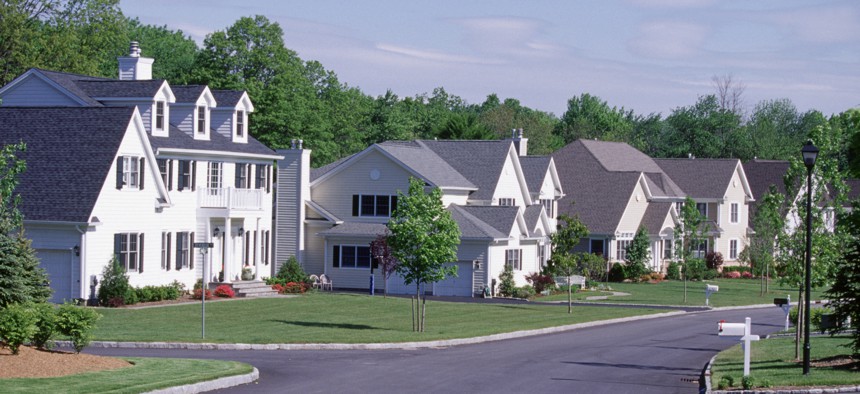Drive-by Property Appraisals Streamline Data Collection

GettyImages/Alan Schein Photography
A Kansas county is using vehicles outfitted with rooftop cameras and LiDAR units to quickly and inexpensively capture property images that are integrated into its cloud-based appraisal system.
Historically, property appraisers in Johnson County, Kansas, drove up to each structure, took photos and then entered them into a system when they were back at their office computer. This year, however, the county has gone digital.
As a result, appraisers will get more and better imagery, do their jobs online and travel to only those locations requiring additional verification. The result will save about $2 million, said Beau Boisvert, county appraiser.
“Two people doing 1 mile of road – both sides of the road – that took us a little over 20 minutes to do both sides, stop and go,” Boisvert said of the previous practice. “One appraiser drove the car. The other sat in the car with the [SLR] camera, and when they got in front of each house, they stopped to take a picture. That’s 20 minutes for a mile.”
By contrast, between December 2021 and January, drivers took four CycloMedia Technology vehicles outfitted with five cameras and a LiDAR unit mounted on the roof and automatically captured imagery every 16 feet while driving the speed limit, said Alex Hepp, director of assessment at the company. All five cameras are triggered at once, capturing 100-megapixel, 360-degree images as well as static images. In total, the drivers covered more than 4,000 miles of road and collected more than 1.4 million recording points (those spots at 16-foot intervals) in addition to about 190,000 JPEGs.
CycloMedia hosts the images in a secure Microsoft Azure cloud-based server and can integrate with the county’s verification software, powered by Tyler Technologies. Using application programming interfaces, appraisers can move the data from CycloMedia into the Tyler mass appraisal system. There, the county’s seven appraisers – Johnson said there will be 20 by the end of June – can determine whether someone has made changes to the property that could affect its value. They also use the 360-degree views to look around the neighborhood to see if changes occurred that would affect the appraisal.
Now, every trip appraisers make to the field tends to be for updating the data, said Jake Wilson, director of Tyler Verify, Appraisal and Tax. “So rather than going out and measuring an entire street and finding out, ‘Hey, I really only had to make two or three changes,’ now you can take care of some of that more efficiently in the office.”
The county is required to appraise 17% of its 260,000 properties each year, covering all of them within a six-year period. “When we assign the work out, every appraiser gets their percentage of that 17% within their market areas and then they have to review them and then turn in the documentation after they make the changes or corrections in the systems,” Boisvert said. They also note when nothing’s changed on the property, he added.
Currently, the county is in the process of putting all of the JPEGs into the system, he said.
One of the key benefits is the ability to enhance the images in-house. “We can actually look at the pictures and a lot of times, if one’s a little bit dark or a little on the light side depending on the angle of the sun, we’re able to adjust that ourselves without sending it back to Cyclomedia and Tyler to shoot a new picture,” Boisvert said. “We’re able to correct [that] ourselves before we embed them into our system for the JPEGs. The previous systems that I worked with, you weren’t able to do that on your own.”
Additionally, the technology automatically blurs out faces and license plates to protect privacy. If appraisers catch an image that needs additional blurring, they can click a button indicating the problem, and CycloMedia remedies it, Hepp said.
The county also analyzes other images such as aerial and orthogonal views. It has worked with Tyler’s mass appraisal system for about 30 years to study the physical characteristics that make up the building and help calculate cost and the sales market to determine appraised value of the property.
But because CycloMedia captures more than just a resident’s property in its images, other departments and jurisdictions may take advantage of the data. For instance, in Coral Gables, Florida, officials used CycloMedia images to look at several city assets: storm drains, signs, sidewalks, curbs and gutters, wheelchair-accessible pedestrian ramps and pavement.
Other uses for imagery include natural disaster simulations. In Wake County, North Carolina, officials turned to analytics and machine learning to make more accurate assessments.
Currently, three Johnson County workers from other departments are being trained on the technology, Boisvert said. “I anticipate down the road we will have many more of our jurisdictions using it,” he said. “There’s a lot of value to it.”
Stephanie Kanowitz is a freelance writer based in northern Virginia.
NEXT STORY: Drive-by property appraisals streamline data collection





